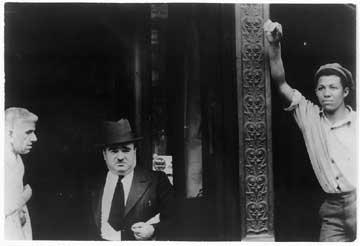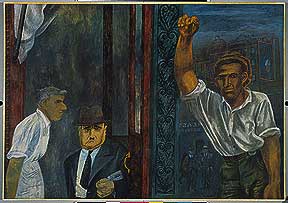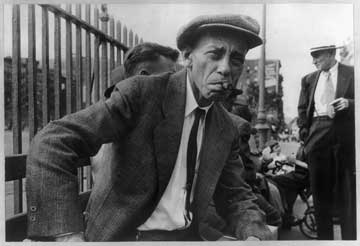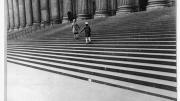Ben Shahn liked to tell the story of being introduced to someone as "Shahn the painter" and being asked if he was any relation to "Shahn the photographer." It's as a painter--and a graphic and commercial artist, illustrator, and muralist--that Shahn is best remembered. Yet his fame could just as easily rest upon his little-known photographs.
Early in his career, Shahn understood that for him art had to tell a story, had to engage its times, and not merely mimic Europe's master painters. The Passion of Sacco and Vanzetti, a series of 23 gouaches, tells the story of the two immigrant Italian anarchists and their infamous trial and 1927 execution for murder and robbery. The reputation-making work was exhibited in 1932 in New York and at Harvard--in spite of the fact that Shahn had caricatured Abbott Lawrence Lowell, then president of the University, as one of the case's central villains. (Lowell was head of a committee charged by the governor of Massachusetts to judge whether the anarchists had been fairly tried; their verdict was yes, and the men were duly executed.) These paintings propelled Shahn to the forefront of the American Social Realists, a group of artists whose gritty images of contemporary society attacked injustice and dehumanization and expressed a common passion for social justice.
Throughout a prolific and popular career spanning nearly four decades, an innate humanism guided the art and activism of the Russian-born, Brooklyn-bred Shahn (1898-1969). Through didactic murals for public spaces, powerful posters for governmental and political organizations, and witty illustrations for myriad magazines and record and book jackets, he found relevant and fruitful means to practice his graphic skills and employ his political beliefs. All the while he generated his "Sunday paintings," works created on his own, off the clock, that grew more personal and contemplative. A 1947 retrospective at the Museum of Modern Art and another MOMA-organized exhibition at the Venice Biennial in 1954 (alongside the abstract expressionist Willem de Kooning) cemented Shahn's international renown.
 |  |
In 1969, Harvard's Fogg Art Museum presented Ben Shahn as Photographer, the first comprehensive exhibition of his photographs. It spotlighted his work for the Farm Security Administration, whose cadre of photographers, including Walker Evans, Dorothea Lang, Arthur Rothstein, and Margaret Bourke-White, documented during the Depression the lives of that "third of a nation"--in FDR's words--"ill-housed, ill-clad, ill-nourished." That exhibition helped establish Shahn the photographer, masterful and compassionate.
This year, the Harvard University Art Museums reveal yet another facet of his photographic work in Ben Shahn's New York: The Photography of Modern Times. In the early thirties, Shahn took to the streets of his beloved city, armed with a small, unobtrusive, handheld Leica camera equipped with a right-angle lens viewfinder that allowed him to shoot his subjects unaware and capture scenes of ordinary life, poverty, and protest in lower and midtown Manhattan neighborhoods.
"Shahn's New York photographs chronicle a pivotal point in the artist's career, when he emerged as a leading photographer in the field of social documentary," says Deborah Martin Kao, Menschel curator of photographs at the Fogg. "Visitors to the exhibition will experience an artistic reconstruction of Depression-era New York."
The traveling exhibition, more than five years in the making, further enables visitors to trace how Shahn turned to the photographs--"intimate, down to earth, human in scale," in the words of the exhibition catalog--as inspirations for his socially conscious drawings, paintings, prints, posters, and public-mural projects. "They played an invaluable role," says Kao, "as primary research tools for his work."
Shahn's talent and fame brought him to Harvard repeatedly. In 1956-57, he delivered the Charles Eliot Norton Lectures in the humanities, which Harvard University Press published as The Shape of Content, an influential treatise still in print. That same year he was artist-in-residence with a studio on the top floor of the Fogg.  Exhibitions at Harvard include the 1932 debut, a 1956 retrospective, and the 1969 photography survey. Harvard awarded him an honorary degree in 1967.
Exhibitions at Harvard include the 1932 debut, a 1956 retrospective, and the 1969 photography survey. Harvard awarded him an honorary degree in 1967.
The Stephen Lee Taller Ben Shahn Archive, an extensive collection of Shahn's prints, drawings, and related ephemera now located at the Fogg Art Museum and Fine Arts Library, coupled with the comprehensive collection of more than 5,000 of the artist's photographs, donated to the Fogg in 1970 by his wife, have made the University an outstanding resource for scholars of Ben Shahn and his contemporaries. The University has also established "Ben Shahn at Harvard," an extensive, searchable database of images and text (accessible via www.artmuseums.harvard.edu).
With these photographs, which the artist called "documents for myself," we see the faces, scenes, and issues that moved Shahn. We are further privileged to see him make them a wellspring for his later images and messages. Placed side by side in the exhibition, these works amply document Shahn's power to speak clearly and lyrically across the decades.






